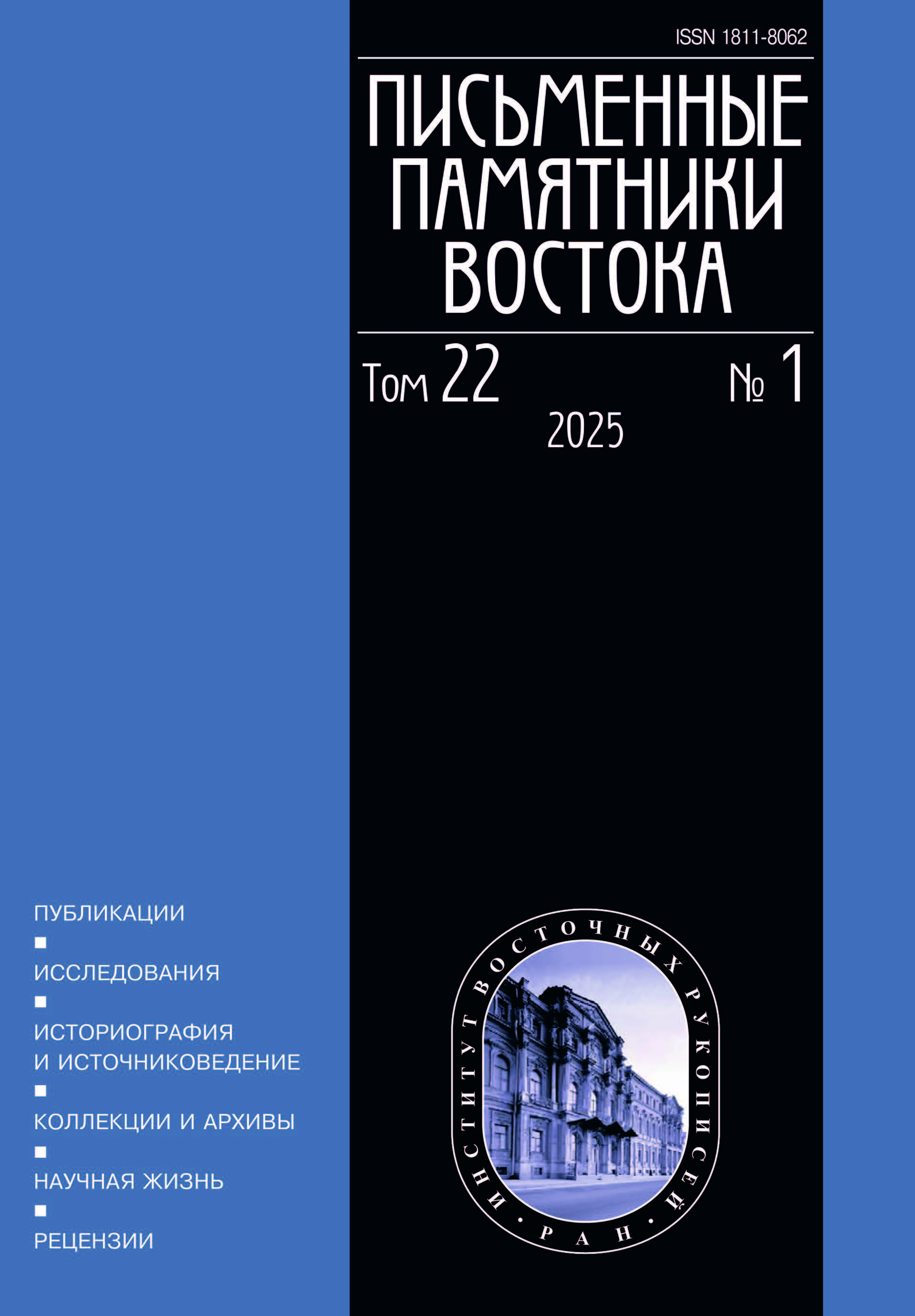«Четыре части» речи в «Ригведе» и последующей традиции
- Авторы: Десницкая Е.А.1
-
Учреждения:
- Институт восточных рукописей РАН
- Выпуск: Том 22, № 1 (2025)
- Страницы: 87-99
- Раздел: Исследования
- Статья опубликована: 29.04.2025
- URL: https://journals.eco-vector.com/1811-8062/article/view/641612
- DOI: https://doi.org/10.55512/WMO641612
- ID: 641612
Цитировать
Полный текст
Аннотация
В статье рассматривается представление о «четырех частях» или «четырех четвертях» речи, впервые упомянутое в «Ригведе» I.164.45. Интерпретация строф этого гимна, известного также как «гимн-загадка», заведомо проблематична. В контексте самого «гимна-загадки» образ речи, разделенной на четыре части либо же стоящей на четырех ногах, отсылает к отождествлению речи с коровой, исполняющей желания. Однако в последующей традиции этот образ получил иное наполнение. В ранних комментариях (в «Шатапатха-брахмане» и в «Нирукте») четыре части речи связываются с языками различных существ или с различными типами физических звуков. Грамматисты на протяжении веков интерпретировали «четверти» как четыре морфологические части речи: имя, глагол, приставку/предлог и частицу. Примечательно, что соотнесение «четырех четвертей» с представлением об уровнях речи, восходящем к философии Бхартрихари (V в. н.э.), впервые в рамках грамматической традиции было произведено только Нагешей Бхаттой в XVIII в. Вне грамматической традиции отождествление «четвертей» и уровней речи встречается в комментариях Саяны (XIV в.). Интерпретация Саяны интересна также и тем, что он, вероятно, следуя учению тантр, соотносит уровни речи с чакрами и описывает последовательный подъем праны в человеческом теле в процессе разворачивания речи от высшей (parā) до артикулированной (vaikharī).
Ключевые слова
Об авторах
Евгения Алексеевна Десницкая
Институт восточных рукописей РАН
Автор, ответственный за переписку.
Email: khecari@yandex.ru
ORCID iD: 0000-0001-7890-2061
кандидат философских наук, научный сотрудник сектора Южной Азии Отдела Центральной и Южной Азии
Россия, Санкт-ПетербургСписок литературы
- Десницкая 2024 — Десницкая Е.А. Критика учения Бхартрихари об уровнях речи в «Шивадришти» Сомананды // Письменные памятники Востока. 2024. Т. 21. № 1 (вып. 56). С. 36–48. doi: 10.55512/WMO625853.
- Елизаренкова, Топоров 1979 — Елизаренкова Т.Я., Топоров В.Н. Древнеиндийская поэтика и ее индоевропейские истоки // Литература и культура древней и средневековой Индии. М.: Наука, 1979. С. 36–88.
- Маламуд 2005 — Маламуд Ш. Испечь мир: ритуал и мысль в Древней Индии. М.: Вост. лит., 2005.
- Avalon 1933 — Avalon A. (ed.). Śāradā-tilaka Tantram. Delhi: Motilal, 1933.
- Bandhu 1960 — Bandhu V. (ed.). Atharvaveda (Śaunaka) with Sāyaṇācārya’s Commentary. Part I. Hoshiarpur: Vishveshvaranand Vedic Research Institute, 1960.
- Brereton 1988 — Brereton J.P. Unsounded Speech: Problems in the Interpretation of BU(M) 1.5.10 = BU(K) 1.5.3 // Indo-Iranian Journal. 1988. Vol. 31. P. 1–10.
- Brereton 1999 — Brereton J.P. Edifying Puzzlement: Ṛgveda 10.129 and the Uses of Enigma // Journal of the American Oriental Society. 1999. Vol. 119. No. 2. P. 248–260.
- Bronkhorst 1987 — Bronkhorst J. (ed.) Mahābhāṣyadīpikā of Bhartṛhari. Fascicule IV: Āhnikā I. Poona: Bhandarkar, 1987.
- Desnitskaya 2020 — Desnitskaya E. Nonagonistic Discourse in the Early History of Indian Philosophical Debates: From Brahmodyas to the Mahābhāṣya // Framing Intellectual and Lived Spaces in Early South Asia: Sources and Boundaries. De Gruyter, 2020. P. 145–171.
- Houben 2000 — Houben J.E.M. The Ritual Pragmatics of a Vedic Hymn: The “Riddle Hymn” and the Pravargya Ritual // Journal of the American Oriental Society. 2000. Vol. 120. No. 4. P. 499–536.
- Iyer 1966 — Iyer K.A.S. (ed.). Vākyapadīya of Bhartṛhari with the Commentaries Vṛtti and Paddhati. Kāṇḍa I. Poona: Deccan College, 1966.
- Joshi, Roodbergen 1986 — Joshi S.D., Roodbergen J.A.F. (ed.) Patañjali’s Vyākaraṇa-Mahābhāṣya. Paspaśāhnika. Poona: University of Poona, 1986.
- Olivelle 1998 — Olivelle P. The Early Upanishads: Annotated Text and Translation. Oxford: Oxford University Press, 1998.
- Padoux 1990 — Padoux A. Vāc: The Concept of the Word in Selected Hindu Tantras. New York: SUNY, 1990.
- Rajvade 1933 — Rajvade V.K. (ed.). Ṛgvedasaṃhitā with the Commentary of Sāyaṇācārya. Vol. I. Poona: Tilak Maharashtra University, 1933.
- Sarup 1998 — Sarup L. (ed.). The Nighaṇṭu and the Nirukta. Delhi: Motilal, 1998.
Дополнительные файлы








